Mass Delusions in Astronomy
by Bill Lauritzen
You are delusional. It is my duty to tell you this as a psychologist. In fact, you are part of a mass delusion that has gripped the globe. I would call it a delusion of the “grandiose type,” and unfortunately it has gone undetected for millennia.
Do not despair, your prognosis is good, and it is my intention to cure you and others of this delusion. It is my intention that you have seen your last “sunset.” For the sun doesn’t set, my friend.
Although you see the sun “come up” or “go down,” we have known for several hundred years, since about the time of Galileo in 1633, that THE SUN DOES NOT MOVE. (Some of you may know of galactic rotation and other motions which are of no concern to us here.) We live in a heliocentric not a geocentric system. If you see it move, if you see it rise or set or even travel across the sky, you are seeing something that is not possible. Hence my diagnosis of delusion.
Here’s an analogy that might help: we have all experienced sitting in an auto or train and having another vehicle sitting nearby. Suddenly we think we are moving, but it turns out that the other vehicle was really moving. We are disoriented for a second while we transition to the correct orientation. Humanity sees the sun moving, so we will go through a transition phase. The end result will be for humanity to collectively see the Earth spinning, not the sun moving. This transition phase may last a long time—perhaps hundreds of years or more. It will be a disorienting period. However, I think we will be fully cured.
You might protest: But it looks like the sun is moving! Ludwig Wittgenstein, the Austrian philosopher, used to say, “What would it look like if the sun were not moving?” The answer to this question is, of course, that would look exactly as it looks now. It is not our sensations that are at fault, but what model our brain is using to organize those sensations. It is our perception that is at fault.
Here’s another analogy: imagine that it is a very black night, with no moon and cloud covered. You are sitting and someone appears to be holding a candle while walking around you. All you see is a flickering flame moving round you. However, then the full moon rises and you see that in fact you are on a merry-go-round, and that what you thought was a candle was in reality a large forest fire miles away. Likewise, we are on the “Earth-go-round.” Hope you are enjoying the ride.
Historical Background
For thousands of years, perhaps hundreds of thousands of years, humanity has suffered from this delusion that the sun moves round the Earth.
In the Bible, it mentions the “sun” about 190 times using words such as “going in,” “go in,” “gone in,” “sunk,” “rise,” “riseth,” “risen,” “rising,” “set,” “setting.” (Young’s Literal Translation.) Nowhere does the Almighty Lord’s Book mention the Earth spinning and the sun being stationary, except when Joshua asks Jehovah to make the sun “stand still,” which it does temporarily while Israel takes vengeance on its enemies.
In the Koran, I found 41 references to the sun, also using such words as, “rise,” “sunrise,” “declining,” “rising,” “runs,” “follows,” “pursuing.” (Shakir translation.) Although Allah “created the sun,” there is no hint that it is stationary with the Earth going round it. It is important to note that NO ANCIENT RELIGIOUS OR MYTHOLOGICAL STORY OR TEXT GOT THIS RIGHT.
It was not until the Golden Age of Greece that we have a record of someone getting it right. Although Aristotle championed a geocentric system, there was a Greek, by the name of Aristarchus, (310-230 BC) who correctly stated that the sun was the center of the solar system. Few believed him and the heliocentric theory was never popular in ancient Greece.
What was popular in Greece and elsewhere was a book by Ptolemy, (100-178 AD), called by the Arabic name Almagest (The Greatest), a geocentric interpretation. This was to be the leading astronomical book for over 13 centuries until the time of Copernicus (1473-1543). It was quite a feat to diagram the movements of the planets based on a false model, but Ptolemy managed to do it using a complicated system of small circles on top of a larger circle.
Delusions of the “grandiose type” are one of the following: 1) delusions of inflated worth, power, knowledge, identity, or 2) special relationship to a deity or famous person. In our case, the last one applies: we think we have a special relationship to a deity, in other words, God. We think that God made Earth the center of the Universe and put us on it. Modern science knows better, but our common language, with its ancient, widespread roots, still puts the Earth at the center.
Copernicus (1473-1543) found that Ptolemy’s complicated system could be done away with and everything easily explained and if the sun were put at the center of the system. He eventually wrote a book, De revolutionibus orbitum coelestium (On the Revolutions of the Heavenly Spheres). Copernicus was very reluctant to publish, seeking additional confirming data. The book was only published very near to his death, dedicated to Pope Paul III. It presented the heliocentric theory rather apologetically and defensively as just sort of a mathematical hypothesis. In the introduction (which some say was not written by Copernicus) it says, “It is not necessary that these hypotheses should be true, or even [probable].”
Giordano Bruno (1548-1600) was an infamous occult philosopher that professed that the Earth went round the sun, and that there were infinite worlds besides Earth that were inhabited. He was declared a heretic and burned at the stake, although it is unclear if this was for his sun-centered views. Today the SETI (Search for Extraterrestrial Intelligence) League gives a Memorial Award in his honor for his “infinite worlds theory.”
Galileo was not apologetic like Copernicus, nor foolishly arrogant like Bruno. He wholeheartedly championed the sun-centered system in his brilliant Dialogue Concerning the Two Chief World Systems. However, he was forced to come before the Inquisition in Rome in 1633 to take back his statements. He was then placed under house arrest and ordered to publish no more about the heliocentric hypothesis.
Three hundred and fifty nine years later, in October of 1992, Pope John Paul II offered an apology for the Galileo affair. The apology said scripture should not be taken literally when describing the physical world, and so Galileo was complemented for being more correct in his interpretation of scripture than the theologians of the time.
In the twentieth century the maverick genius Bucky Fuller coined the term “Spaceship Earth,” and developed a spherical-shaped device, a “Geoscope,” a miniature Earth, for viewing the stars. Its axis is parallel to the Earth’s axis. The 4,000 mile distance between the Earth’s center and the Geoscope is negligible when compared to the distance to the stars. These facts allow one, while sitting inside the Geoscope, to experience the Earth as a planet among the stars. Something most of us have never done.
Inspired by Fuller’s practical means of directly experiencing reality, I began thinking about ways to change our perceptions of the stars (including our own) from the archaic pre-Copernican to a more modern scientific perception.
Semantic Readjustment
Part of my cure for our mass delusion lies in semantics or the meanings of words.
Benjamin Lee Whorf (1897 – 1941) and his teacher Edward Sapir proposed that language influences our thinking. This is now known as the Whorf-Sapir hypothesis and in its “strong form” states that both our culture and thoughts are dependent on the language we use. In this form, our language, in effect, determines our reality, and this so this is sometimes called "linguistic determinism."
Most scientists accept a weaker form of this hypothesis. Or they believe that language and thoughts have mutual influence on each other.
I like to say that language, thought, and perception interact in an eternal dance. The ancient astronomical terms, the ones in common use today, are a good illustration of this.
The words “sunset,” “sunrise,” and “sundown” have been with us for many thousands of years. Many more years than we have known about the motionlessness of the sun. These words express the idea that the sun moves. And, as Whorf and Sapir said, they influence our reality. They help to build the model that we have in our brain of the world.
However, by using words that are archaic and false-to-fact we are perpetuating a delusion upon ourselves and others. Using new words that are semantically more correct is the solution.
Alfred Korzybski (1879-1950) also wrote about semantics. He said no word or statement or model can exactly match reality. He often stated it like this: “The map is not the territory, the word is not the thing.” According to Korzybski the best we can hope for is a good structural match between the words and the reality.
Bucky Fuller (1895-1983) suggested using “sun sight” for “sun rise” and “sun eclipse” (or “sun ‘clipse”) for “sunset.” Although this is an improvement, I thought something a little more catchy might work better. So I use “spin out” or “spin away” for “sunset” and “spin in” or “spin to” for “sunrise.” I have taught these terms to many students of all ages.
In other words, we “spin away” from the sun, and later we “spin to” the sun. These statements match reality better than “sunset.” They better match the structure of the solar system. (I should mention that although the sun does not move round us, it does move round the center of the Milky Way Galaxy along with other stars, but that motion is not significant for our purposes.)
| Archaic | Fuller’s | Your Author’s |
|---|---|---|
| sunrise | sun sight | spin-in or spin-to |
| sunset | sun ‘clipse | spin-out or spin-away |
In addition, the fact that the sun is a star, although certainly envisioned by many of these pioneers, was not formally proved until after 1838, when Friedrich Bessel for the first time measured the distance to a star. Other scientists calculated the brightness of stars, and found them to be about as bright as our sun. Other things about our sun were also found to be like those of stars, such as temperature and chemical composition. Van Gogh’s (1853-1890) famous work, Starry Night, was inspired by his realization that the stars were also suns, like our own.
So the word “sun” is also a misnomer. I propose using the word “home star” for now on, in all communications about the “sun.” The use of this word will also help move us out of our mass delusion that the “sun” is moving.
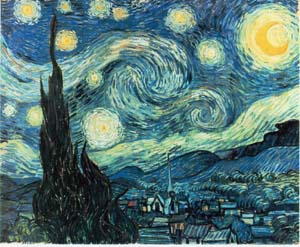
You also may now notice that your perspective on the solar system changes. You may see and even feel the distance between yourself and the “home star” differently. Look at the “sun” and say aloud: There is the Home Star! You have begun to create in your brain a more correct model of reality.
We learn when we are very young something called “relative size.” This is the ability to judge distances based on size. Here’s another analogy: I show you a photo of a tiny model car with an all white background. Then I tell you it’s a real car. Suddenly it is much larger and more distant than you thought.
Something like this happens when you use the word home star instead of sun.
Also now that you know what you are dealing with, a star, you can viscerally compare the true distance between our home star and the other stars.
If you do it at “sunset,” the effect is quite noticeable and almost overwhelming. The Earth will shrink in size, and the home star will recede in distance, until you perceive them correctly, in true proportion, within the immense span of the solar system.
You can play with this. Look at the home star and say, “It’s the sun, it’s the home star, it’s the sun, it’s the home star…” and see what happens with your perceptions.
By the way, the other stars are all there, but because we are so close to the home star its brightness blinds us.
| Traditional | Suggested |
|---|---|
| sun bathing | home star bathing |
| sun block | home star block |
| sunbeam | home star beam |
| sunlight | home star light |
| sundeck | home star deck |
| Sunday | Home Star Day |
| sunny | starry |
| the sun is out | the home star is visible |
The heavens were considered somehow perfect and not like the Earth. When Galileo first pointed his telescope towards the Moon and the rest of the known planets, oh, how I wish I could have been there! I always imagine that the hair on his body stood up as he saw for the first time mountains on the Moon! Or when he saw moons going round Jupiter.
So now we can say that the “sunset,” is really the spin-out from the home star. Go outside and point and say proudly to your neighbor, “Look! We are spinning away from the home star!” You are spreading a more correct model. (I suppose some would say a more correct meme. Those who use the meme nomenclature would say we have been infected with a false meme. And I am trying to disinfect us.)
There is another important factor in all this: the Earth is tilted as it spins. Perhaps it was knocked over at some time in the distant past. Which brings us to another delusion: “solstices.”
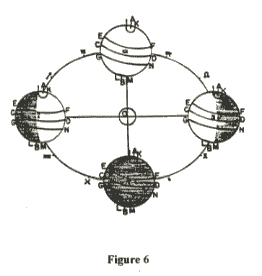
The Solstice
The ancient people perceived the “sunset” at different places along the horizon. The “sun moved” further south each day until one day it seemed to “stand still.” Solstice (Sol-stice) literally means “sun stop.” Then the “sun” began to “reverse it’s motion.” Each day it “rose” and “set” further north. This was a time of celebration because the people knew that spring and summer were coming back, that the “sun” was “returning.”
You too probably notice that the ring of the horizon intersects our star at different points, depending on the time of year. If your streets are laid out in north-south-east-west directions you may have at least noticed that sometime in the spring and fall driving becomes difficult due to the glare from the sun. That was at the equinox when the horizon line intersects the sun exactly due east and due west.
In the diagram, I have marked points where the spin-away intersection points occur at the various months of the year from a latitude near Los Angeles.
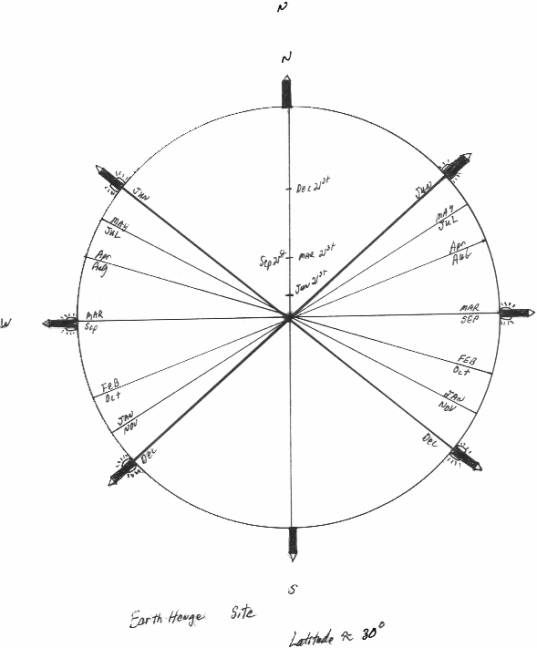
The lower right and lower left are what I call Horizon Intersection Points (HIPs) for the December “Solstice.” The upper right and upper left are the Horizontal Intersection Points for the June “Solstice.” The east-west marks are the HIPs for the Fall and Spring Equinox.
The ancients marked the “sun stop” with a hill or rock on the horizon and later a perhaps a pole, a stone, or a place where the light struck a certain rock. This information would help them to know exactly when the seasons were changing. They could plant crops with more confidence or prepare for coming weather conditions. Eventually they built the many stone circles that exist throughout England and Northern Europe and the huge stone structure of Stonehenge.
These rings of stone are not what they seem. The ancients did not know that the “sun” was motionless in the center of the solar system. They did not know the Earth whirls. They did not know that the Earth was tilted from being straight up by 23.5 degrees. They did not know the Earth rounds the home star at about 18.5 miles per second. They did not know they were actually building an Earth Orbit Tracking Device, or what I call Spacehenge.
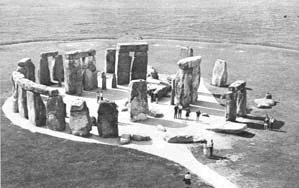
As before, you are delusional if you think it is the home star that is somehow shifting along the horizon day by day. Once again, for our purposes here, THE HOME STAR DOES NOT MOVE. What is happening is the Earth is SHIFTING its position with respect to the home star.
The Earth is a spinning ball that is tilted in a fixed way as it goes round a home star. It is the tilt and the motion around the home star that creates these shifts in the intersection point along the horizon.
We in the northern hemisphere (where 95% of humanity lives) are tilted most toward the home star in the summer. We are tilted most away from the home star in the winter. (Of course, it is just the opposite in Australia. When we are tilted toward, they are tilted away.) There are better names than Solstice and Equinox which are Orbital Points One, Two, Three, and Four.
| Traditional | Suggested | Orbital Point |
|---|---|---|
| Winter Solstice | Tilt-Away Orbital Point | 0 or 4 |
| Spring Equinox | Spring Orbital Point | 1 |
| Summer Solstice | Tilt-In Orbital Point | 2 |
| Fall Equinox | Fall Orbital Point | 3 |
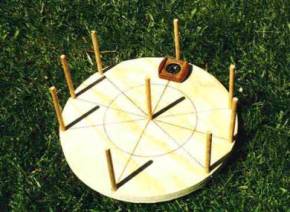
I have built three Spacehenges so far. A portable hand model and a larger one in the desert. And also a portable one which I can take apart and set up again at the beach. I built these to help people to break out of their delusions. To face the world as it is. Spinning, tilted, orbiting the home star, and last but not least round, the last delusion I will discuss.
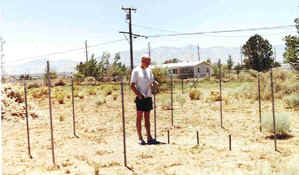
Seeing the Round Earth
I have wondered if there were ways that someone could experience the round Earth directly, besides going to high altitudes. In fact, I have wondered if perhaps the perception of a round Earth was natural, and that the flat Earth mind-set is learned though faulty language programming.
Perhaps through the use of the words "up" and "down" (which don't exist in a round world), through the use of a right-angled (x,y) coordinate system, through the use of flat maps, and through other subtle words and phrases in many different disciplines, we slowly lose our sensation of the round Earth, and in our mind we begin to perceive it as flat, despite all the NASA photos and video.
For example, in geology they talk of "plate tectonics," which makes you think that the "plates" that make up the earth's crust are flat, like plates. In actual fact, they are huge curved structures nothing like a plate, but more like an upside down bowl.
Maps actually cover these large bowls. Continents, nations, states, counties, and cities exist on upside down bowls. Oceans cover bowls. The Great Plains of the U.S. is actually a Great Bowl. Plateaus are not flat, but curved.
Another example comes from the weatherman. He says that the wind "blows." We know, when we blow on our soup, that "blowing" occurs in a straight line. However, the wind is moving in anything but a straight line. If it did move in a straight line, it would very shortly be on its way to Mars. The wind "curves" gently from the northeast. Or it curves strongly from the southwest, etc. Using the word "curves" immediately summons up a view of the global dynamics of weather and gives one the immediate impression that weather is not a linear, flat-plane subject, and that it thus can not be predicted easily.
Other examples from meteorology: Hurricanes are actually not flat, but exist as huge domes of atmosphere. Low pressure systems and high pressure systems are both domes of air. Fronts exist as huge arcs. So the sky is a dome above us. The only fiction writer whom I have seen express this somewhat correctly was Thomas Wolfe. In one of his novels he mentions the "arc of the sky."
We might all be familiar with one particular method of perceiving the round Earth that particularly impressed me one day. If you live near the ocean, as I do, you can watch the ships come in to port. Near Long Beach Harbor, a very busy harbor by the way, I saw an interesting sight. Two large cargo ships identical in design were passing each other except that one was about five miles off the coast and the other was only a mile off the coast. The one that is further out was showing much less of her hull. At first, I though this was some sort of an optical illusion, but then I remembered that I, of course, was living on a round Earth, and I immediately felt a sort of sick feeling in my gut as I experienced it. It was frightening, yet wonderful.
I happened to have a portable telescope in my car, which I was able to focus on the two ships which had the effect of intensifying the experience. The ocean, for the first time, LOOKED curved.
Since then, I have been trying to think of other ways to experience the round Earth. One particular method came to me which anyone can try, even if they don't live near an ocean or are not an astronaut.
The key is to watch clouds, particularly at spinout. At this time, we often see layers of colorful clouds. The layers more distant are usually much smaller and much lower. However, we now know that cloud systems are generally at a certain altitude above the Earth. If you have ever been in an airliner or watched pictures from orbit then you have seen this.
So, the next time you experience this layered phenomenon just remember that these distant, "lower layers" are actually (in general) at the SAME altitude above the earth as are the nearer "layers." As you reorient your vision, you should experience the round Earth. The effect is definitely noticeable. Try it.
Even if you don't live near the ocean or on a large curved plain, I think you will notice that the clouds are in different positions than they would be than if the world were flat. Or, try it with this photo.

If one realizes that these clouds are all at about the same altitude then the Earth will begin to appear round.
In fact, I think this flat-Earth mind set explains the so-called "moon illusion." This is the illusion that the moon looks larger near the horizon than when directly overhead. No one has really come up with an adequate explanation for this illusion, although many prominent scientists and thinkers have tried. Like many unsolved problems in science it is mis-named. It should be called the "Flat Earth Illusion."
Of course, one should also realize that there is no "horizon." There is no line separating the Earth from the sky, and if you walk toward it it always moves away. It is really a gradual dropping off as the Earth curves. It might be better to call it the "horizon curve."
If one sees the Earth as flat, when the moon is pictured against this flatness which must somehow extend off into infinity, it seems larger in comparison. If one re-educates their nervous system to see the Earth as round rather than flat (something I have found it possible to do, although it takes a little work), when one looks at the "horizon curve," one will no longer see the moon as larger at the horizon.
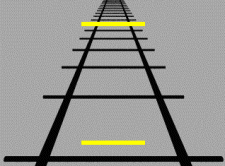
The Ponzo "Illusion," is a set of parallel tracks that converge in the distance. Two blocks of exactly the same size are inserted between the tracks. This "background" (in our case the flat Earth mind set) influences our perception of the "foreground" objects-the two blocks (in our case the moon). The farther of the two blocks appears significantly larger than its nearer companion. Dr. Carl J. Wenning says,
"The explanation of the Moon Illusion, then, is that it is nothing more than the Ponzo Illusion inverted!" This is not quite accurate. The Ponzo "Illusion" is not really an illusion. In the context of the 3-D information given to us, it is correct for our senses to infer that the top block is larger. To then switch and say it is really 2-D information is not fair.
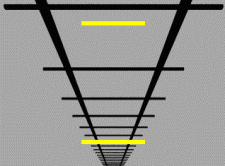
The fact is that you can see a round Earth all the time. But there is a lot of denial about it. I am not sure why. It seems like our sensory system is calibrated against a flat Earth.
But we don't have to be a slave to our antiquated language and oversimplified models. We can overcome them. We can recalibrate our sensory system. We can see a round Earth.

This photo shows the Earth's spin. The city you see and the water you see are not on a flat surface but sit on the curved surface of the Earth. Buildings in the background appear shorter than they are due to the curvature of the Earth. If one concentrates on this, and the fact that the moon is about 240,000 miles away, then then the moon in this image appears the same size throughout the sequence. However, further testing could be done to verify this.
Summary and Future Scenario
In the table, in the first three rows, I summarize the data I have discussed so far. Another delusion I haven't mentioned is the so-called rising of the moon and the rising and setting of various stars and constellations, and also the appearance of various constellations at various part of our orbit (various times of the year.) These are mentioned in rows 3 and 4. It is probably that these delusions (and others) interact.
| Delusion | Cure |
|---|---|
| "Sunset" Sun and Star motion in sky | Use “spin-out," spin-in," spin-by," and " home star.” |
| "Solstice" and Equinox motion of sun | Use “orbital points 0, 1, 2, 3”; " year" = " orbit." Use Spacehenge: Earth Orbit Device. |
| "Flat Earth" | Use globes not maps; watch ships at sea; watch clouds at the horizon. |
| Moon and stars "rising" and "setting." | Use "spin-in" and "spin-out." |
| Constellations appearing in night sky at different seasons. | Use “orbital points 0, 1, 2, 3” which face different stars in Milky Way at spin-out. Use Spacehenge: Earth Tracking Device. |
I leave you with this possible future scenario:
“This is the 1058th Earth orbit since the beginning of the Atomic Era. My name is Karmato Dozenson. I am an anthropologist. I was born on Earth and have lived here for most of my 45 orbits, except for a half-orbit doing field work on the moon, one vacation to the Space Casinos, and three vacations to High Orbit Space View. Today I stand on the beach, on Oregon Shores, and face our home star as the spin-away is just beginning.
Most of the Solar system has the day off as this is a big holiday. It is Orbital Point One, in ancient times called the Spring Equinox.
Beneath me, slowly the Earths spins, majestically. I am not religious, but there is something magical about a spinout, I guess because you can actually see the Earth spinning.
This one is magnificent due to the partial cloud coverage. The reflection on the ocean is red. The clouds are various shades of pink and red and are changing colors. As I watch we whirl so that the ocean just touches the home star.
I think back to the time of the ancient humans. How odd that they used to think that the sun actually moved. Even when humans first landed on the moon they still used the word “sunset,” and they still saw the sun move. I have seen them talk about this on ancient TV shows.
I try hard to see things from their perspective. I think, “the sun is going down,” but nothing changes. The words sound silly. I have been too conditioned since early childhood to see the Earth turning. To see myself, at spinout, as facing sideways out of the solar system. To see shadows as markers tracing a ray of light on its way out of the solar system.
I try again. I focus all my mental energy and think, “the sun is setting, the Earth is not spinning, the sun is setting, the Earth is not spinning.” Then, for an instant I see it! I see it as the ancients must have saw it! I am thrilled. The sun seems so close and so small, like the moon…
Then everything flips back and the Earth is spinning away once more.
The Earth turns so that the ocean now covers the very last bit of the Home Star. Goodbye Sol. Here in Oregon they will see you again after exactly a 12 hour spin through the outer solar system.
I walk slowly away. It gets cold right after spinout here. And I have to be at the Galapagos Space Elevator in just a twelfth-spin. I am going out for my second trip to the Moon. Voice-corder Off.”
Bibliography:
www.geocities.com/CollegePark/4110/whorf.html
www.psychologynet.org
www.griffithobs.org
Fuller, Buckminster, Critical Path
Copernicus, On the Revolutions of the Heavenly Spheres
Ptolemy, The Almagest
Galileo, Dialog Concerning the Two Chief World Systems
Bible (Young translation) www.biblegateway.com
Koran www.hti.umich.edu/k/koran/